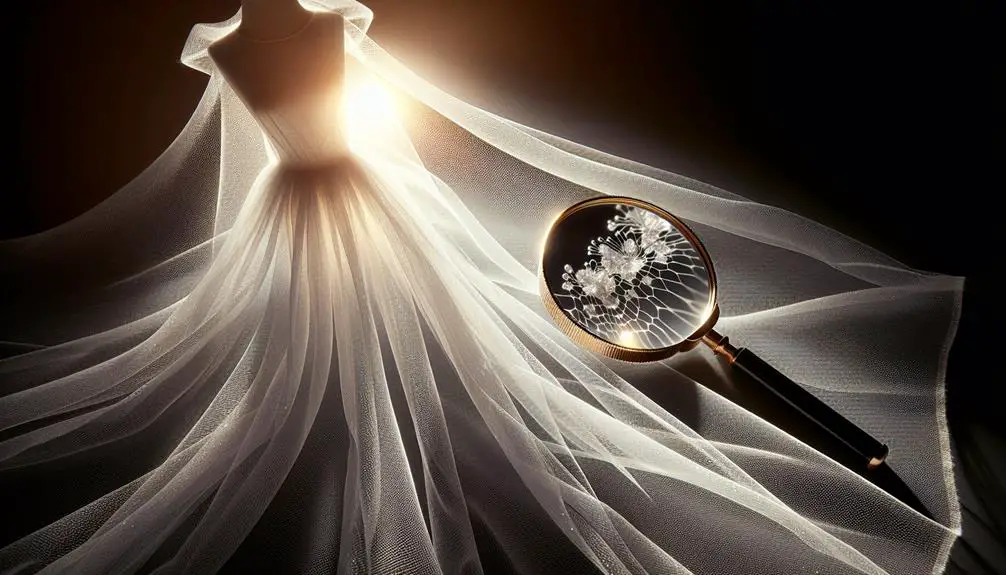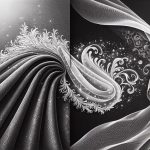I've learned that to determine if fabric is pure organza, start by checking its fiber content. True organza is traditionally made from silk, which gives it a smooth, soft texture. You can also look at the weave; genuine organza has a sheer, stiff, and shiny appearance. Holding the fabric up to light is another easy test—organza's sheerness and uniform weave become apparent. For a more definitive check, gently tug the edges to assess stiffness and see how it rebounds. A crisp feel generally indicates high quality. There's also a burn test, but I'd suggest careful handling or consulting an expert for that. There's plenty more to explore on verifying organza's authenticity.
Table of Contents
Key Takeaways
- Examine the fabric's sheerness and shine by holding it up to a light source.
- Feel the texture for a smooth, crisp quality typical of silk organza.
- Check for uniformity in the mesh weave and consistency in thread thickness.
- Perform a burn test; pure silk organza will leave a fine, powdery ash.
- Consult textile experts for insights on fiber content and weave patterns.
Understanding Organza's Origin
Organza fabric originated in the East, where weavers traditionally crafted it from silk. This delicate, sheer material was a symbol of luxury, often used in the wardrobes of the elite and for special occasions. The craftsmanship required to create organza was significant, involving meticulous processes to maintain its lightweight, crisp texture.
Historically, the production of organza was centered in regions known for their silk cultivation, such as China and India. These countries had the climate and resources necessary for sericulture, or silk farming, which is crucial for producing high-quality silk fibers. The weavers in these areas developed unique techniques to twist and weave these fibers into the distinctively thin yet strong threads that characterize organza.
Understanding its origins helps us appreciate organza not just as a fabric, but as an art form that's been perfected over centuries. It's fascinating to see how this fabric has traveled across continents, evolving in use but retaining its esteemed status. Knowing where it comes from adds a layer of respect for the material and informs our choices in textiles, especially when aiming for authenticity and quality in fashion or décor.
Analyzing Fiber Content
To truly understand what sets pure organza apart, we must delve into its fiber content. Organza can be crafted from a variety of fibers, each imparting unique characteristics to the final fabric. However, pure organza traditionally comes from silk, giving it that luxurious sheen and delicate feel we all love.
Here's a quick rundown to help us get to grips with what we're looking at:
- Silk: The traditional choice for making organza, silk fibers provide a smooth, soft texture that's naturally lustrous.
- Polyester: A more modern take, polyester fibers make organza more durable and resistant to wrinkles, but the feel and sheen can't quite match silk.
- Nylon: Similar to polyester, nylon enhances the fabric's durability and is often blended with other fibers to reduce cost.
- Rayon: This semi-synthetic fiber offers a silk-like feel and appearance, but it's generally less durable and mightn't hold shape as well.
When you're out hunting for the perfect organza, remember that its purest form is silk-based. This not only guarantees the elegant texture and shine but also ensures that delicate, airy lift that only silk can provide. Spotting this can be a game-changer for anyone passionate about their fabric crafts or fashion projects!
Recognizing Weave Patterns
Now, let's talk about recognizing weave patterns in organza fabric.
I'll start by showing you how to identify the way threads interlace, which is key to understanding the fabric's structure.
Then, we'll look at analyzing the mesh uniformity to ensure the quality and authenticity of the organza.
Identify Thread Interlacing
Recognizing weave patterns in fabric, I find it crucial to closely examine the thread interlacing to identify genuine organza.
Here's how I do it:
- Look for Sheerness: Real organza has a thin, sheer texture. I hold it up to the light to see how transparent it is.
- Check the Stiffness: I feel the fabric. Organza should have a slight stiffness, due to tightly twisted fibers.
- Examine Thread Thickness: I use a magnifying glass to see if the threads are uniformly thin.
- Observe the Shine: I look at the fabric under different lighting conditions. Pure organza usually has a subtle, natural sheen.
Analyze Mesh Uniformity
After examining the basic traits of organza, I next focus on analyzing the uniformity of the mesh, a key indicator of weave quality. Pure organza should have a consistently even mesh pattern. Here's how I check it: I hold the fabric up to a light source. This way, any irregularities in the mesh become apparent. You're looking for a regular, grid-like pattern without any random distortions or dense patches.
If the mesh pattern is uneven, it's a red flag. High-quality organza is crafted with precision, and the threads are spaced uniformly. Uneven mesh suggests a lower quality fabric, possibly a blend or a lower-grade silk. Remember, uniformity in the mesh not only affects appearance but also the durability of the fabric.
Testing for Sheerness and Stiffness
To test for sheerness and stiffness in organza, hold the fabric up to light and gently tug at the edges. This simple approach helps me determine if the fabric meets the key characteristics expected from high-quality organza. Here's how I break it down:
- Hold It Up to the Light: If it's genuine organza, light should pass through easily, showcasing its sheer nature. I look for a subtle glow that indicates a fine, lightweight weave.
- Feel for Stiffness: As I tug gently at the edges, I'm feeling for a crispness that springs back. Pure organza has a distinctive structured yet delicate feel. It shouldn't feel limp or overly flexible.
- Check the Edge Rebound: After tugging, I watch how the fabric behaves. Does it return quickly to its original form without sagging? This resilience is a telltale sign of good organza.
- Observe the Body of the Fabric: While the sheerness checks the lightness, the stiffness assessment tells me about the fabric's body. Quality organza should have a certain firmness that supports its shape but isn't too rigid.
These steps give me a clear insight into whether I'm handling true organza, combining practical tactile tests with visual cues to assess its quality.
Checking for a Smooth Texture
Next, I'll check the organza's texture by running my fingers across the surface to feel for any irregularities or roughness. Pure organza should feel uniformly smooth. If you're feeling bumps or snags, that's a red flag. It might indicate a blend or lower quality silk, or even a synthetic substitute.
The texture of genuine organza is also subtly crisp. When I glide my fingers over it, I'm looking for a certain delicate resistance that's characteristic of silk organza woven tightly with fine yarns. This texture isn't just about luxury; it's a practical indicator of durability and quality craftsmanship. If the fabric feels too limp or too coarse, chances are it's not the real deal.
Another thing I focus on is the consistency of the texture across the entire piece of fabric. Variations can sometimes occur even in pure fabrics, but significant inconsistencies often suggest a manufacturing compromise. I pay particular attention to areas near the edges and the folds, where wear or lower quality might be more apparent.
Conducting a Burn Test
I'll now perform a burn test on the organza to discern its authenticity by examining how it reacts to flame. This test helps to determine if the fabric is pure silk organza or a synthetic blend. Here's how you can do it:
- Safety First: Ensure you're in a safe environment, away from flammable materials. Use metal tweezers to hold the fabric sample.
- Ignite: Light a small part of the organza with a lighter or a match. Observe the way it burns and the type of flame.
- Assess the Ash and Smell:
- Ash: Pure silk organza will leave a fine, soft ash that can be easily crumbled between your fingers. If the residue is hard and forms beads, it's likely synthetic.
- Smell: Silk will smell like burnt hair or feathers since it's a natural protein fiber. Synthetics, on the other hand, tend to emit a chemical or plastic-like odor when burned.
- Examine the Flame: Silk burns slowly and will self-extinguish when the flame source is removed. Synthetics melt and usually continue burning.
This test isn't foolproof, but when combined with other checks, like texture analysis, it can guide you towards verifying the purity of your organza fabric.
Comparing Price Points
When we look at the cost of pure organza, there's quite a range to consider.
You'll find that luxury organza fabrics often come with a higher price tag compared to standard ones.
It's essential to understand why these price differences exist and what they mean for your choices.
Market Price Variability
The price of pure organza fabric varies widely across different markets. When you're trying to figure out why there's such a big price range, here are a few things to consider:
- Source of Silk: Organza made from silk sourced from high-quality producers typically costs more.
- Manufacturing Techniques: The methods and the intricacy of the weaving process play a huge role in pricing.
- Import Duties: Depending on where you're shopping, import taxes can significantly affect the final cost of organza.
- Retailer Markup: Different retailers have varying pricing strategies based on their target market and overhead costs.
Understanding these factors helps you navigate the prices better and make more informed purchasing decisions.
Luxury Versus Standard Costs
Understanding the differences between luxury and standard organza costs can clarify why their price points are so distinct. Essentially, it boils down to the materials used and the production methods. Luxury organza is typically made from silk, which naturally drives up the cost due to its delicate extraction and processing. Additionally, high-end organza often incorporates handcrafted techniques, adding to the labor and hence, the price.
On the other hand, standard organza is usually crafted from synthetic fibers like polyester. This not only reduces the cost significantly but also impacts the feel and durability of the fabric. So, when you're comparing prices, you're not just looking at fabric, but the craftsmanship and material quality behind it.
Consulting Textile Experts
Consulting textile experts can clarify the nuances of identifying pure organza fabric. As I've navigated the intricate world of textiles, I've found their insights invaluable, especially when it comes to distinguishing authentic materials from imitations.
Here's why talking to a pro makes all the difference:
- Expertise on Fiber Content: They can explain how genuine organza, traditionally made from silk, differs in feel and appearance from versions crafted from synthetic fibers like polyester.
- Burn Test Knowledge: Experts can demonstrate and interpret the burn test, a method where the fabric's fibers are burned to identify the material based on the ash, smell, and flame.
- Weave Identification: They provide insights into the specific weave patterns unique to pure organza, which is typically a plain weave that's thin and sheer, with a slight stiffness.
- Historical Context: They offer historical context that can influence the authenticity of the fabric – whether it's true organza from its traditional roots or a modern reinterpretation.
Frequently Asked Questions
What Are Common Uses for Pure Organza in Fashion and Design?
I've noticed that pure organza is often used in evening wear, bridal gowns, and accessories because of its lightweight, sheer texture. It adds volume without weight, making it ideal for delicate, flowing designs.
How Should Organza Fabric Be Stored to Prevent Damage?
Just as I was reorganizing my fabric stash, I realized organza needs special care. I store it flat or gently rolled, away from sunlight and moisture to prevent wrinkles and damage.
Can Organza Fabric Be Dyed at Home?
Yes, I can dye organza fabric at home using acid dyes or fabric paint. It's important to handle the delicate material gently and follow specific dyeing instructions to avoid damaging the fabric.
What Are the Environmental Impacts of Producing Organza?
Silk fields versus factories: producing organza can harm our environment due to pesticide use on silkworms and the chemical processes factories use. I'm learning it's not just beautiful; it's a bit burdensome too.
How Can Organza Fabric's Colorfastness Be Tested?
I'd test organza's colorfastness by dabbing a damp white cloth on it. If the color bleeds, it's not colorfast. Always check this before washing to avoid ruining other fabrics with dye transfer.
- How Does Ring Spun Cotton Affect Garment Fit and Shape Retention? - August 13, 2024
- What Are the Challenges in Producing Ring Spun Cotton? - August 13, 2024
- Is Ring Spun Cotton Suitable for Plus-Size Clothing? - August 13, 2024






